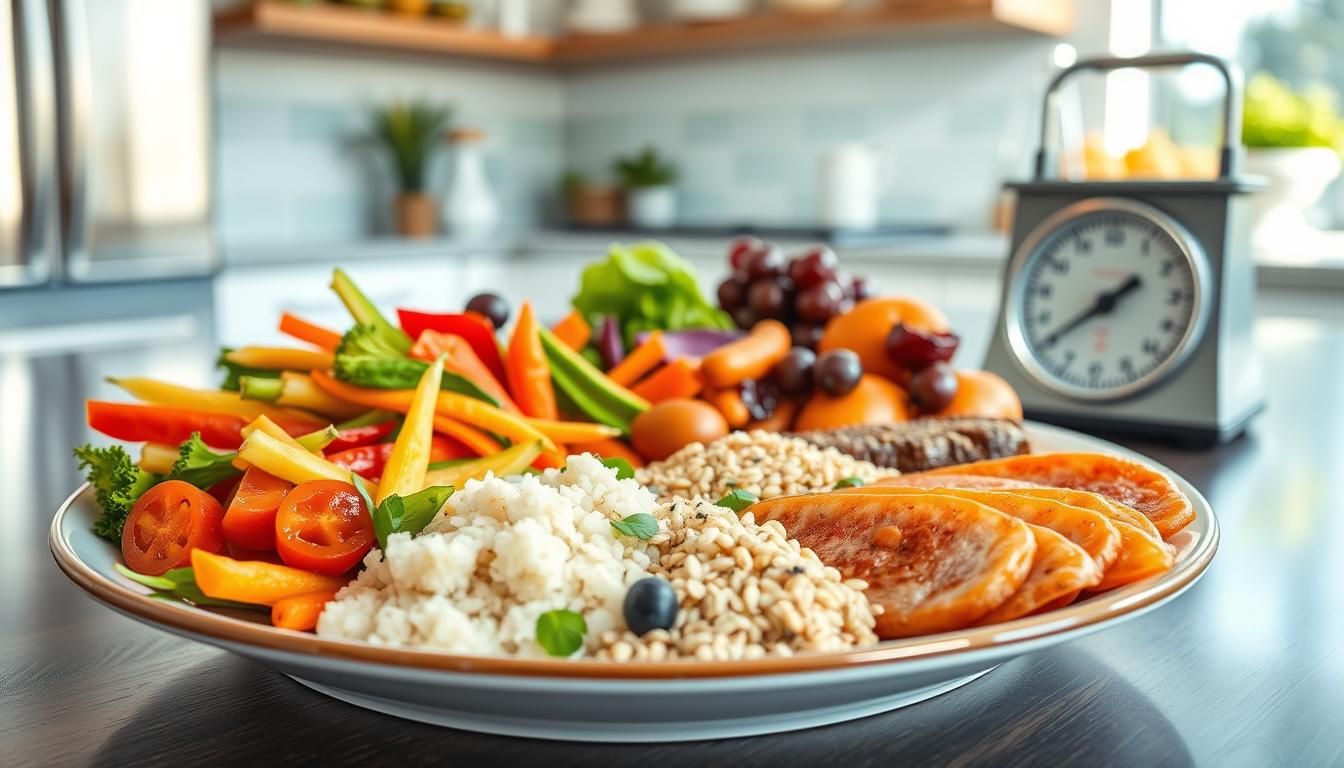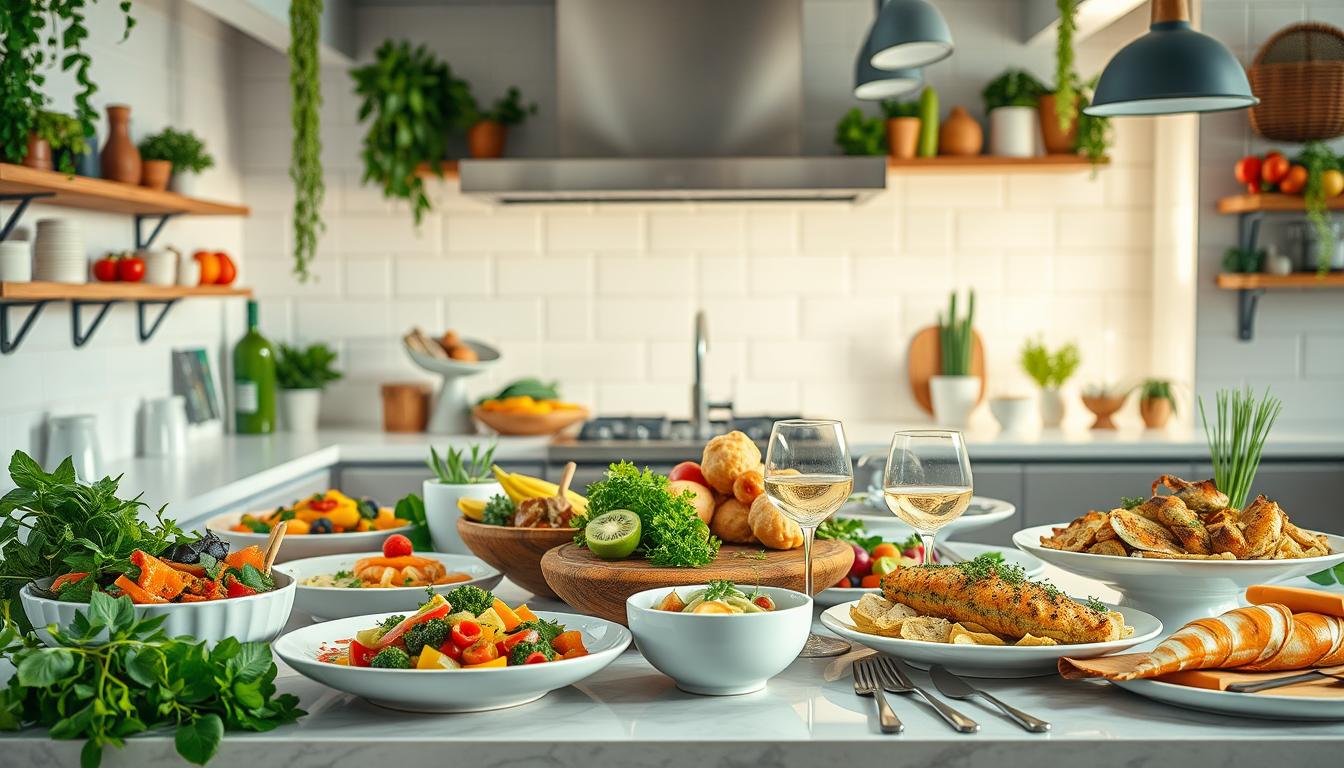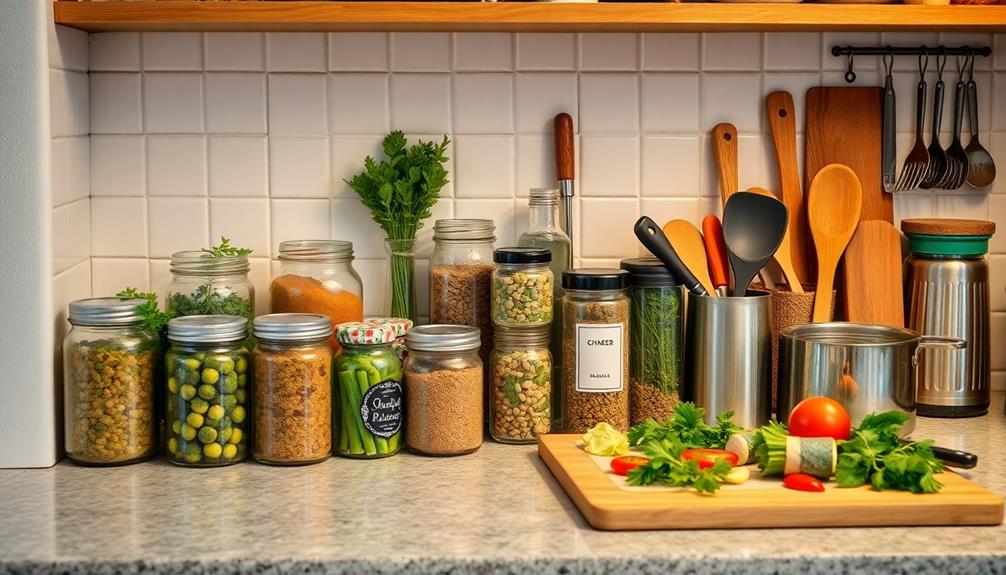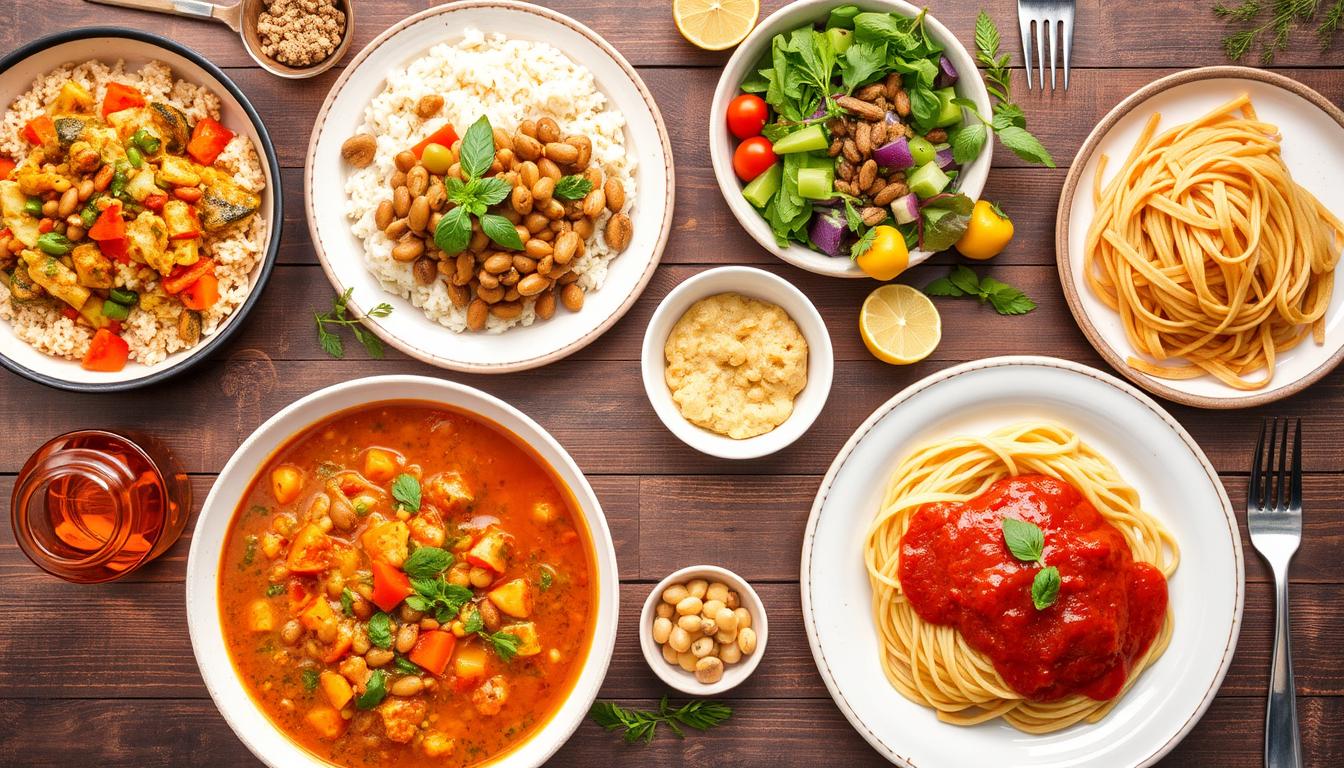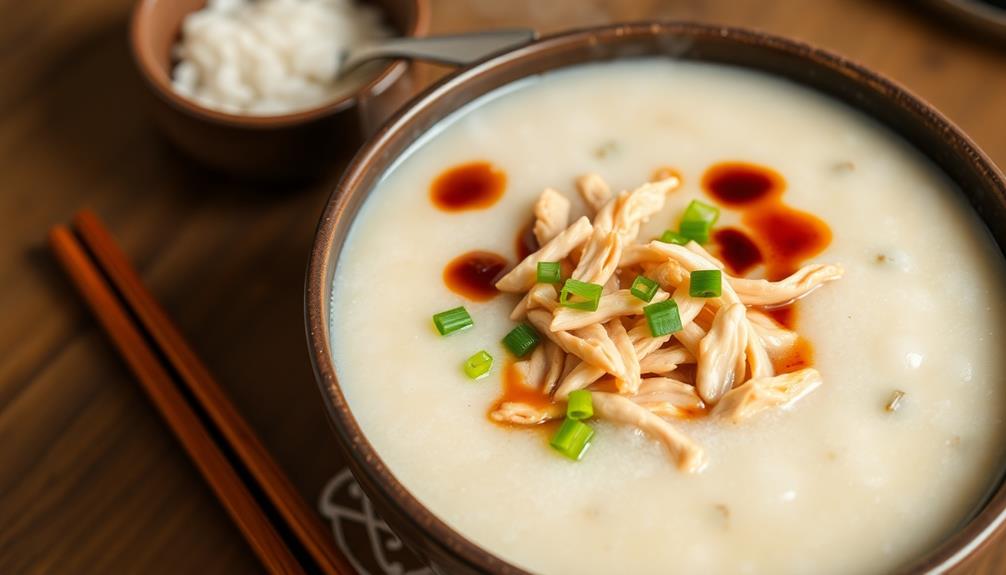When was the last time you paused to consider your relationship with food? In a world where quick meals and super-sized options dominate, mastering meal portion control often feels like an uphill battle. You might find yourself overwhelmed by portion sizes that go beyond what your body truly needs. The implications on your health can be profound, affecting everything from your weight and blood sugar to your blood pressure and hunger levels. But what if you could reclaim your health by taking simple yet effective steps towards better eating habits? Think of this journey as a way to love yourself more—by making mindful choices that nourish your body, you are investing in a healthier and happier you. Let’s explore practical strategies for healthy eating habits that will help you regain control over your meals and enhance your overall well-being. By focusing on portion control and being more mindful of your food choices, you can take a proactive approach to managing your nutrition and wellness. Start by paying attention to your body’s hunger cues and eating slowly to allow your brain to register when you’re full. You can also incorporate more fruits and vegetables into your meals, which not only adds nutrients and fiber but also helps to fill you up. These simple yet powerful nutrition and wellness tips can help you improve your relationship with food and take charge of your health.
Key Takeaways
- Smaller portion sizes can significantly improve your health metrics.
- The Portions Master Plate aids in achieving proper meal portions for weight management.
- Measuring food with your hand can simplify portion control.
- Drinking water before meals can support better portion control.
- Eating slowly allows your body to recognize fullness, preventing overeating.
Understanding the Importance of Meal Portion Control
Meal portion control plays a crucial role in developing healthy eating habits that support long-term weight management. The sizes of meals you consume directly impact your overall health. Research highlights that larger portion sizes often lead to increased food consumption, resulting in excessive calorie intake and potential weight gain. By understanding and implementing meal portion control strategies, you can foster better dietary choices and promote a healthier lifestyle.
How Portion Sizes Affect Your Health
Understanding the visual cues associated with portion sizes can help in making healthier food choices. For example, one serving of fruit should resemble a tennis ball, while a serving of vegetables is similar to a baseball. Carbohydrates should be portioned to the size of a deck of cards; for instance, half a cup of whole-grain cooked pasta equates to one serving, containing about 70 calories. Protein sources, like cooked skinless chicken, should not exceed the same deck of cards, with an ideal portion size ranging from 2 to 2.5 ounces, resulting in approximately 110 calories. Additionally, fats should be treated as special ingredients, with a serving size about the size of two dice, such as 2 teaspoons of mayonnaise that provide around 45 calories. By practicing portion control, you can improve your judgment on serving sizes while emphasizing low-calorie options such as fruits and vegetables.
The Link Between Portion Control and Weight Management
Effective weight management is closely tied to controlling portion sizes. The World Health Organization suggests limiting portion sizes to reduce overall energy intake, thereby decreasing the risk of unhealthy weight gain. Studies indicate that larger portions of high-energy-dense (HED) foods consistently encourage greater energy intake compared to smaller servings. For example, evidence shows that doubling the amount of food offered in laboratory settings typically leads to a significant increase in consumption, around 35%. Furthermore, research involving adolescents indicates a strong correlation between total caloric intake and body mass index (BMI). Each increase of approximately 100 calories results in a measurable uptick in BMI, reinforcing the importance of keeping portions in check to avoid weight accumulation.

Recognizing Portion Distortion in Today’s Food Culture
The phenomenon of portion distortion significantly influences our eating habits, making meal portion control more challenging. Over recent years, the average sizes of food portions have seen a marked increase, contributing to increased instances of overeating. Various studies highlight a troubling correlation between the growth of portion sizes and the rising obesity rates.
How Increased Portion Sizes Contribute to Overeating
Modern food culture showcases a trend of oversized servings across numerous dining venues and packaged foods. For instance, coffee sizes have exploded from a modest 8 ounces containing around 45 calories two decades ago to a staggering 16 ounces, which can exceed 350 calories. Similarly, muffins, once weighing 1.5 ounces at 210 calories, now reach 4 ounces at 500 calories. Such increases prompt consumers to unknowingly consume more than their bodies require, often leading to unwanted weight gain.
Understanding the Super-Sizing Effect
The super-sizing effect plays a critical role in this equation. Individuals often lose track of appropriate serving sizes when presented with larger portions, leading to increased calorie intake. For example, a typical Chicken Caesar Salad grew from 1.5 cups and 390 calories to a hefty 3.5 cups and 790 calories. Furthermore, our perception of what constitutes a standard meal size has dramatically shifted. Guidelines suggest that a 3-ounce serving of meat should be comparable to a woman’s palm or a deck of cards, yet many consumers overlook these recommendations while dining.
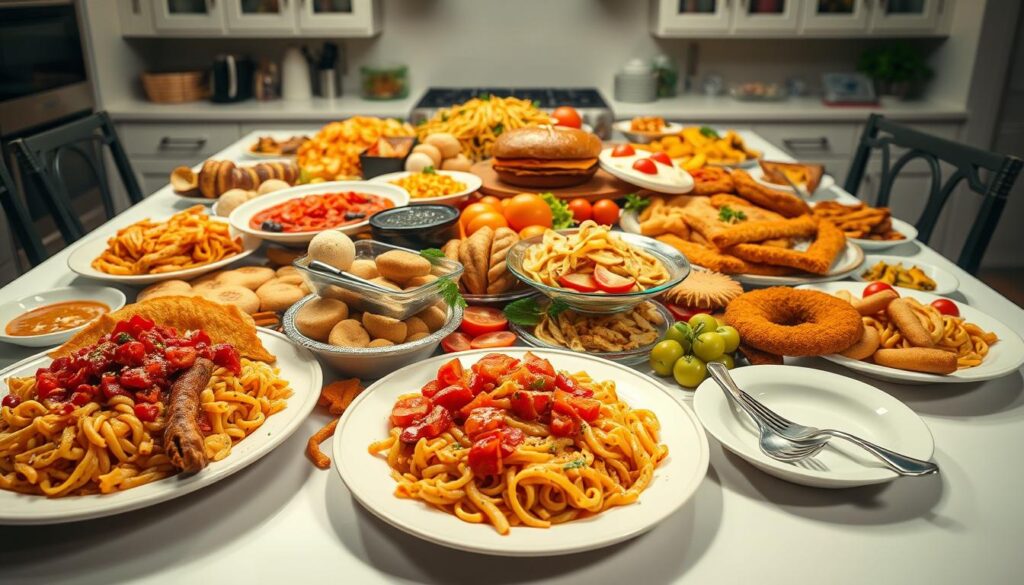
Strategies to Master Meal Portion Control
Implementing effective strategies can significantly enhance your ability to manage meal portions. These practical methods focus on utilizing tools and techniques that make it easier to eat the right amounts and enjoy your meals without overindulging.
Using Smaller Dinnerware for Better Portions
One of the most effective portion control tips is to use smaller dinnerware. Research shows that using smaller plates, bowls, and utensils can reduce food intake by up to 29%. When meals are served on smaller dinnerware, food appears to occupy a larger space visually, leading to greater satisfaction despite consuming less. This simple change can help you manage portion sizes effectively.

How to Ask for Smaller Portions When Dining Out
When dining at restaurants, it’s easy to be overwhelmed by large portions. Implementing effective dining out strategies can make a difference. Don’t hesitate to request smaller portions or share a dish with a friend. Many restaurants are happy to accommodate these requests, allowing you to enjoy their offerings without the excessive calorie load. Opting for two appetizers instead of one large entrée is another smart approach that allows for variety without the risk of overeating.
By utilizing these strategies, you can take control of your meal portions and move towards healthier eating patterns while still enjoying your favorite foods.
Portion Control Tools and Resources
In today’s fast-paced world, utilizing effective portion control tools can significantly enhance your dining experience and support your health goals. With the right resources, managing portion sizes becomes a seamless process, making it easier to track your food intake and maintain balanced nutrition.
Utilizing Apps like Portions Master for Tracking
One of the most innovative solutions available today is the Portions Master App. This convenient application enables you to track your calorie intake and manage your portion sizes effortlessly. By allowing you to create custom portion sizes, it encourages mindful eating habits. Through its user-friendly interface, you can quickly log your meals and stay accountable. Such portion control tools are essential for anyone aiming to improve their dietary choices without the hassle of counting every calorie manually.
Overview of the Portion Plate and Its Benefits
The Portion Plate is another excellent resource designed to visualize and manage your food intake. This specialized plate features compartments that indicate appropriate serving sizes for different food groups, helping you maintain balanced meals easily. With its clear guidelines, the Portion Plate supports your weight loss goals by simplifying portioning. By using this tool, not only do you gain control over how much you eat, but you also reduce waste and enhance your overall eating experience.
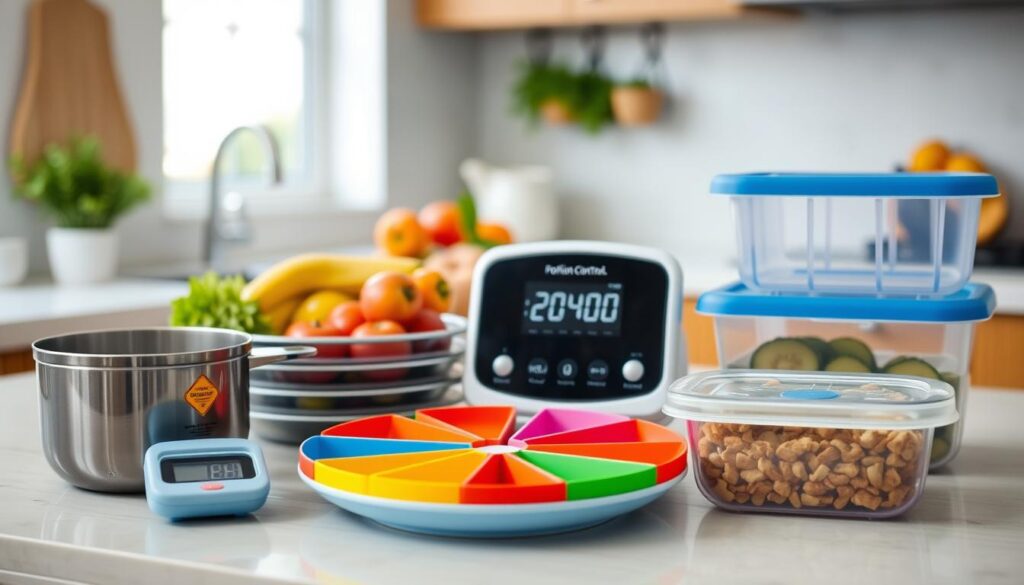
The Role of Mindful Eating in Portion Control
Practicing mindful eating can significantly enhance your portion control skills, guiding you to pay closer attention to your food and the sensations of hunger and fullness. By embracing this approach, you develop a stronger connection with your meals and improve your overall eating experience.
Practices to Enhance Mindful Eating
To cultivate mindful eating habits, consider implementing the following practices:
- Put down your utensils between bites. This simple action allows you to savor each mouthful and recognize when you feel satisfied.
- Limit distractions. Eating without distractions can help you to focus on your food and your body’s signals, making it easier to gauge when you’re full.
- Serve smaller portions. Using smaller plates creates the illusion of a larger meal, promoting satisfaction with reduced portions.
- Eat slowly. Taking your time to chew your food can improve digestion and enhance enjoyment.
Focusing on Satiety Signals
Recognizing and responding to satiety signals is essential in mastering portion control. The body requires about 20 minutes to register that it has been fed, creating a delay in the feeling of fullness if meals are consumed quickly. By practicing mindful eating, you can become more attuned to your body’s natural cues.
Dietary guidelines suggest that half of your plate should be filled with fruits and vegetables, which can help regulate portion sizes. Moreover, utilizing resources such as the National Institute on Aging’s quantity and quality guide offers valuable insights into appropriate serving sizes based on individual needs, including age, gender, and activity level.
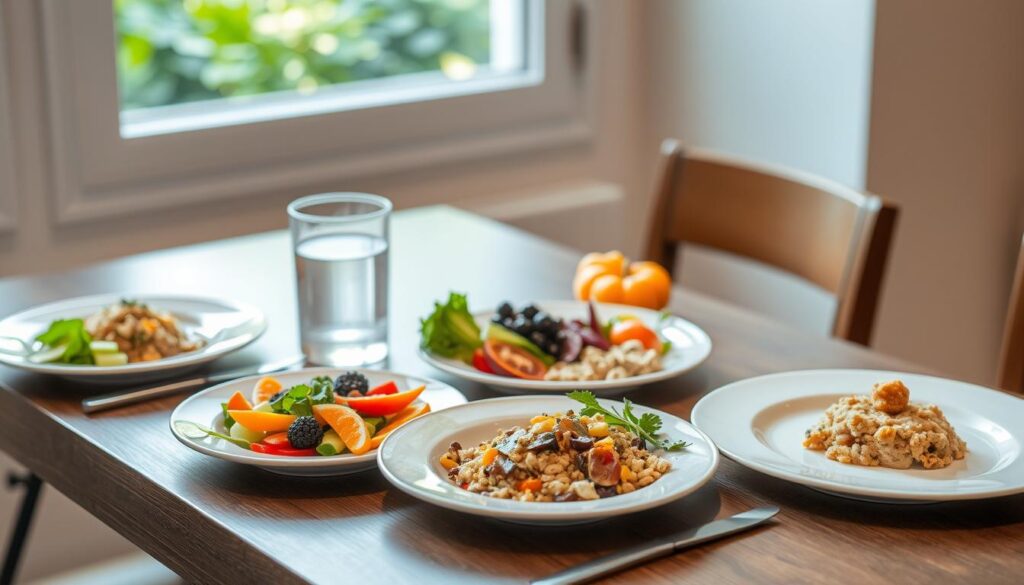
Creating a Balanced Diet with Proper Portion Sizes
When you aim for a balanced diet, understanding proper portion sizes plays a crucial role. The balance involves allocating enough space on your plate for each food group. Getting familiar with macronutrient ratios allows you to maintain a healthy diet while controlling calorie intake. Implementing these strategies helps you create visually appealing meals that meet your nutritional needs.
A Guide to Macronutrient Ratios on Your Plate
To create your meals effectively, consider the following macronutrient ratios:
- 1/2 of your plate should consist of vegetables and fruits
- 1/4 of the plate dedicated to lean proteins
- 1/4 reserved for whole grains
This simple division encourages a balanced intake of essential nutrients. The DASH Eating Plan recommends high-potassium and low-sodium foods, focusing on fiber-rich grains and protein options. Using tools such as ChooseMyPlate.gov can help tailor these ratios to suit your unique dietary needs.
How to Include Vegetables Effectively
Incorporating vegetables into your meals is essential for achieving a balanced diet. Here are some effective strategies:
- Shop for a variety of colorful vegetables to enhance the visual appeal of your meals.
- Experiment with different cooking methods, such as steaming, roasting, or grilling, to bring out unique flavors.
- Consider salads as starters that can fill you up while providing essential nutrients.
By focusing on these strategies, you can effectively manage portion sizes while ensuring an abundance of vegetables contributes to your nutritional goals. Keep in mind that a plate filled with colorful vegetables promotes satiety while remaining low in calories.

Calorie Counting: A Tool for Portion Control
Calorie counting serves as an effective tool to help manage portion sizes and understand daily intake. By actively engaging in tracking caloric intake, you can promote better eating habits while supporting your weight loss efforts. Various approaches, including the use of portion control containers, simplify this process by providing pre-measured portions for different food groups.
Benefits of Tracking Your Caloric Intake
Utilizing calorie counting allows you to gain insights into your eating habits. Some benefits include:
- Enhanced awareness of portion sizes, which aids in meal planning.
- Ability to combine physical activity with dietary choices for balanced energy expenditure.
- Monitoring intake helps maintain a calorie deficit for effective weight loss.
- Elevated accountability which often leads to healthier eating behaviors over time.
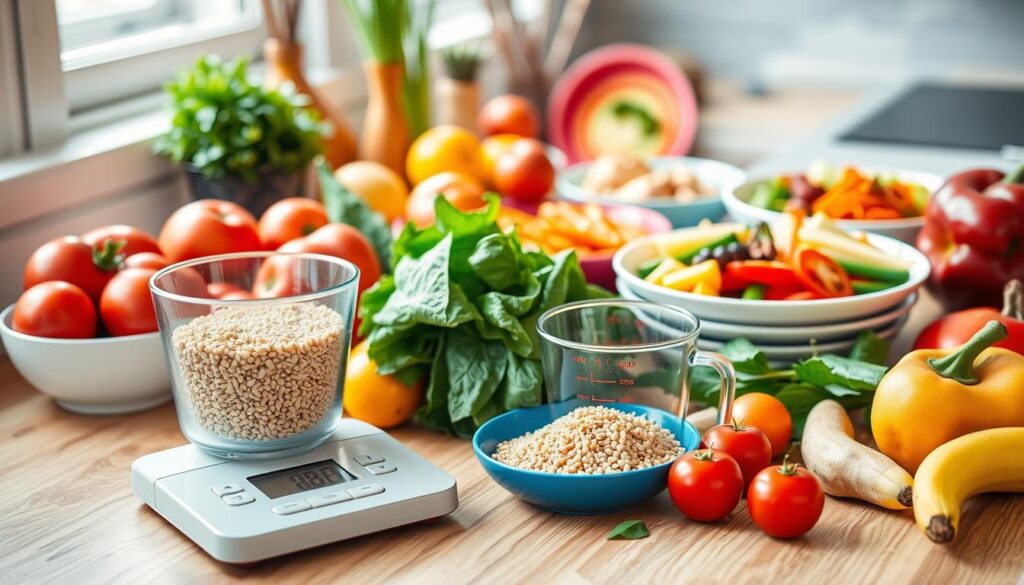
Challenges of Calorie Counting
Despite its benefits, calorie counting presents challenges. It can sometimes lead to an unhealthy fixation on numbers rather than the nutritional value of food. Some common hurdles include:
- The potential for an unhealthy obsession with calorie limits.
- Ignoring food quality in favor of number tracking.
- Difficulty adjusting to the balance between calorie counting and mindful eating.
Finding the right harmony between calorie counting and portion control tips ensures a sustainable approach to weight management. By incorporating practices like using smaller plates and being mindful of the food you consume, you can achieve your health goals while enjoying a balanced diet.
| Method | Advantages | Challenges |
|---|---|---|
| Calorie Counting | Promotes awareness and accountability | Can lead to unhealthy obsessions |
| Portion Control Containers | Simplifies portion sizes and emphasizes balance | May not address calorie quality |
Using Your Hands as Portion Control Guides
Understanding portion control can feel overwhelming, especially with the myriad of methods available. One intuitive approach utilizes your hands as natural measuring tools. This hand serving guide has proven effective for many individuals, offering a practical way to gauge the appropriate size of food portions.
Learn the Hand Guide for Different Food Groups
Each hand size can provide an effortless way to determine your food intake. Here’s a helpful breakdown:
| Food Group | Portion Measurement | Equivalent Size |
|---|---|---|
| Protein | 1 palm | 20-30 grams or 3-4 ounces of cooked meat/tofu |
| Vegetables | 1 fist | Approximately 1 cup of non-starchy vegetables |
| Carbohydrates | 1 handful | 20-30 grams or 1/2-2/3 cup of cooked grains/legumes |
| Fats | 1 thumb | 7-12 grams or 1 tablespoon of oils, nuts, seeds, or cheese |
Advantages of This Method Over Measuring Tools
The hand portion control methods present various benefits compared to traditional measuring tools. Primarily, this technique allows for personalized estimations that fit individual needs. Larger individuals naturally require larger portions, while smaller individuals can rely on their hand sizes for appropriate servings. As a result, you can enjoy a more sustainable approach without extensive calorie counting or strict weight measurements. The ease of using your hands simplifies meal preparations and fosters a healthier relationship with food.

Healthy Eating Habits to Support Portion Control
Adopting healthy eating habits can play a crucial role in managing portion control successfully. Integrating simple practices into your daily routine will enhance your overall eating experience and help maintain a balanced diet. Two effective strategies in this regard include starting meals with water before meals and adopting an eating slowly approach.
Starting Meals with Water for Better Satiety
Drinking water before meals can enhance feelings of fullness, which may lead to consuming fewer calories overall. Studies indicate that this simple practice can effectively curb appetite and reduce the tendency to overeat. By making it a habit to drink a glass of water prior to your meals, you’re more likely to keep your portion sizes in check and enjoy a more satisfying dining experience.
Eating Slowly: How It Affects Your Intake
Taking the time to eat slowly allows your body to register satiety signals more efficiently. When you eat at a leisurely pace, you give your brain the opportunity to process the food intake and recognize when you’re satisfied. This practice not only benefits portion control but also enhances your appreciation for the flavors and textures of your food.
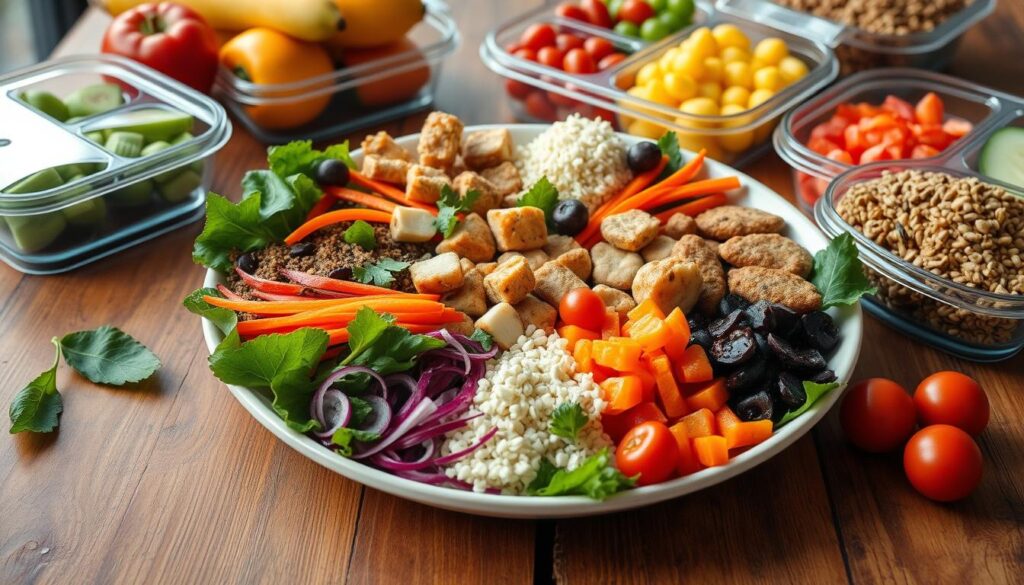
| Practice | Benefits |
|---|---|
| Water before meals | Reduces calorie intake, enhances fullness |
| Eating slowly | Improves satiety recognition, promotes mindful eating |
Tips and Tricks to Avoid Overeating
Practicing tips to avoid overeating can significantly enhance your ability to manage portion sizes and consume healthier meals. Implementing effective portion control strategies helps in recognizing triggers that lead to excessive eating. Here are some practical approaches you can adopt.
Avoid Eating from Large Containers
Eating directly from large containers often leads to unconscious overeating. When engaging with large packages, you may not realize just how much you’re consuming. To combat this, serve your snacks in small bowls. By doing so, you can better monitor your intake and enjoy your favorite treats without the risk of overindulgence.
Keeping Serving Dishes Away from the Table
It can be tempting to leave serving dishes on the dining table. This practice often makes it easy to indulge further during meals. Consider keeping serving dishes away from the table. Doing so encourages you to focus on the portions on your plate and reduces the likelihood of continual grazing. By applying this simple portion control strategy, you can maintain better awareness of your food intake.
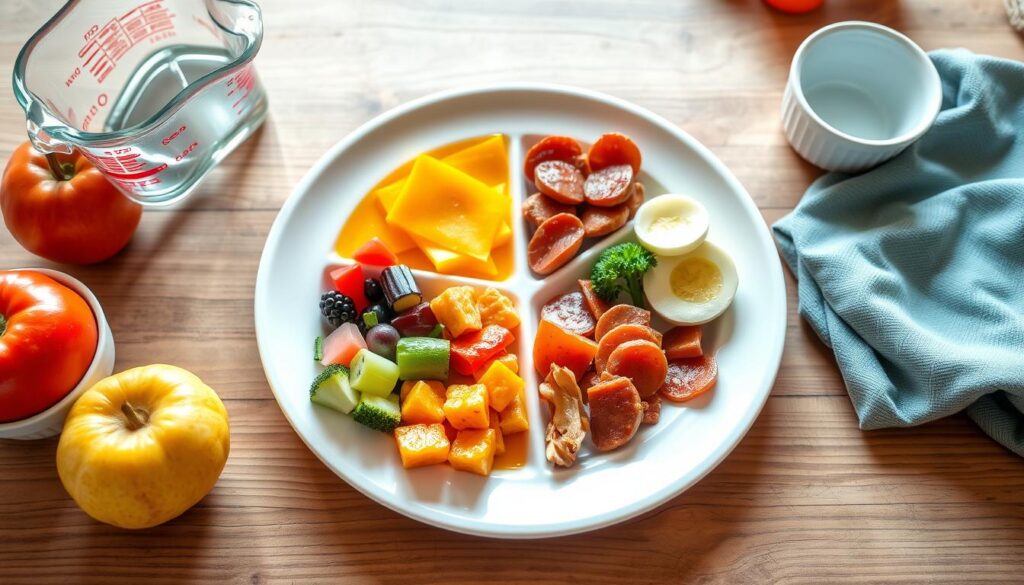
Meal Portion Control: Psychological and Environmental Factors
Understanding how psychological factors and environmental factors impact your meal portion control is crucial. These elements can drastically affect your eating habits and, in turn, your overall health. Recognizing the influence of distractions while eating plays a significant role in achieving healthier portion sizes.
The Impact of Distractions While Eating
Distractions while eating, such as watching television or scrolling through your smartphone, can significantly contribute to mindless eating. When your focus is divided, you may consume more calories without realizing it. Studies indicate that engaging in these distractions can diminish your awareness of portion sizes and satiety signals. As a result, this leads to an increase in the overall energy intake during meals.
How Lighting and Serving Settings Affect Your Meal
The environment where you eat, including factors like lighting and table settings, shapes your perception of food. Brighter lighting has been found to promote mindfulness, making you more aware of the portion sizes on your plate. Conversely, dim lighting may encourage larger servings and less attention to your food choices. Social settings and the presence of others can also create implicit pressure leading to larger portion sizes. Being mindful of these environmental factors can empower you to make better choices regarding your meal portion control.

Conclusion
Mastering meal portion control is fundamental for anyone keen on pursuing a healthier lifestyle and effective weight management. The evidence is compelling: portion sizes directly affect energy intake, with individuals consuming significantly more calories when served larger portions. By understanding the correlation between portion sizes and overeating, you can take deliberate steps to create healthier eating habits that support your wellness goals.
Utilizing strategies such as using smaller dinnerware and practicing mindful eating can dramatically improve both digestion and satiety cues. Additionally, meal prepping can serve as a valuable tool for balancing your plate with the right nutrients while controlling portions. With awareness and practical approaches, you can make informed choices that benefit your overall health.
By focusing on meal portion control, you are not just managing your weight; you are also setting the stage for a sustainable lifestyle. Remember, every bite counts, and understanding your portions is the first step towards a healthier you. Embracing these principles will help you navigate the challenges of our food environment while ensuring that healthy eating becomes a natural part of your daily routine.
